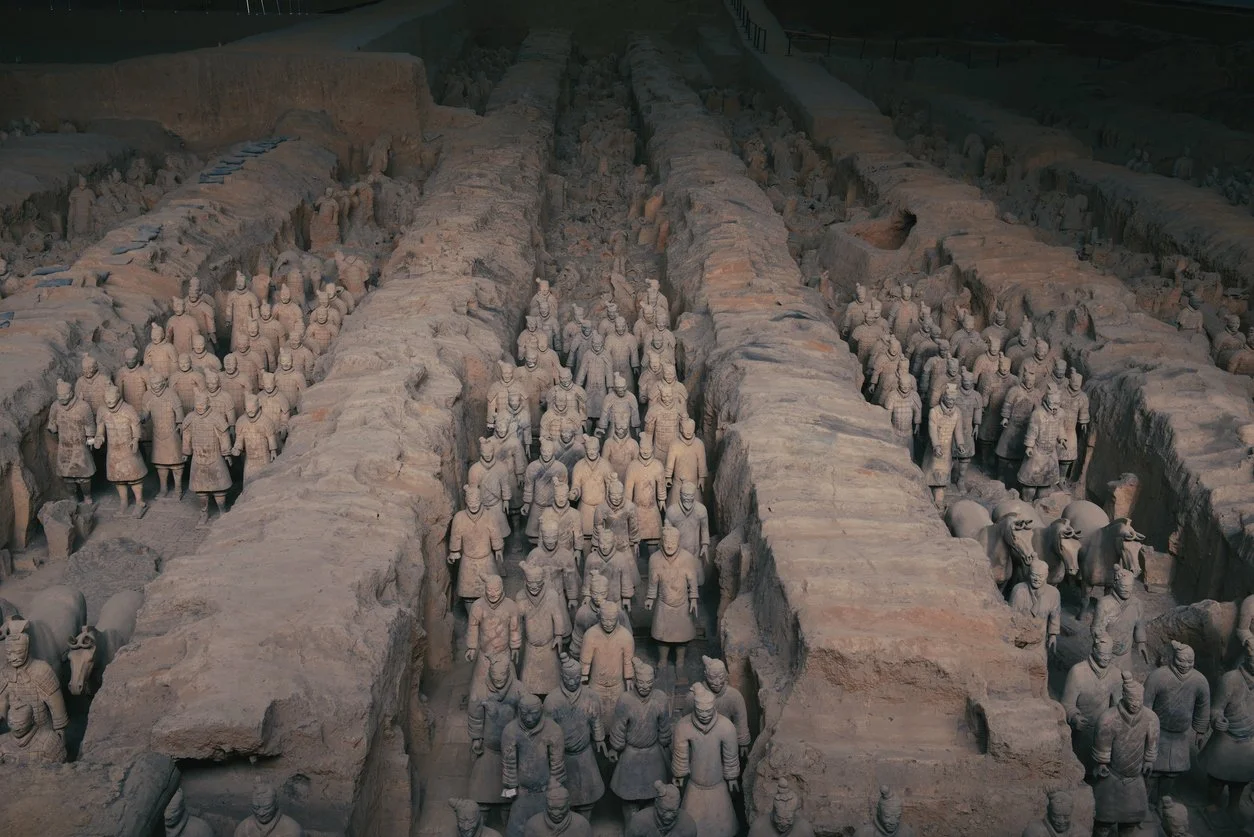The tomb of the First Emperor, also known as the Mausoleum of the First Qin Emperor, is the burial complex and mausoleum of Qin Shi Huang, the founder of the Qin Dynasty and the first emperor of a unified China.
According to the Records of the Grand Historian by Sima Qian (a historian from the Han period), Qin Shi Huang was born in 259 BC in Handan, the capital of Zhao.
He was given the name of Ying Zheng or Zhao Zheng – Zheng being his month of birth “Zhengyue”, the first month of the Chinese lunar calendar.
Around 246 – 247 BC, the 13-year-old Ying Zheng succeeded his father to the throne of Qin and reigned for 36 years as Qin Shi Huang until his death in 210 BC.
Qin Shi Huang’s reign brought about the unification of China and an end to the Warring States period in 221 BC. He constructed a series of walls to connect fortifications along the empire’s northern frontier (the precursor to the Great Wall of China) and built a national road system and the Lingqu Canal.
Although some historians see Qin Shi Huang’s rule as one of tyranny, he did enact several major economic and political reforms to standardise the Chinese states incorporated into his Empire and worked to completely abolish the feudal system of loose alliances and federations.
During his life, Qin Shi Huang became obsessed with immortality and sought the elixir of life. He sent ships in search of Penglai mountain on an inhabited island, where an ancient magician known as Anqi Sheng was said to reside. Qin mythology believed that immortals resided on the mountain and knew the secret to everlasting life.
It was this obsession with immortality that would be Qin Shi Huang’s downfall, as many historians propose that he died from prolonged poisoning due to regular consumption of an elixir containing mercury. Mercury exposure would undoubtedly cause a decline in function of the central nervous system and result in severe brain and liver damage.
Qin Shi Huang was buried in the Mausoleum of the First Qin Emperor, a large complex commissioned when he first became emperor. The mausoleum is located in present-day Lintong District in the city of Xi’an, and was constructed over 38 years using 700,000 workmen (based on historical text).
The structure of the mausoleum is situated beneath a 76-metre-tall hillock (mound) shaped like a truncated pyramid, however, due to soil erosion the pyramid now stands at 47 metres tall. The base of the pyramid measures 515 x 485 metres and is situated within a rectangular, double-walled enclosure.

Excavations around the complex have discovered around 7,000 (estimates suggest up to 8,000) statues of terracotta warriors, horses, officials, acrobats, strongmen, and musicians, and around 100 wooden battle chariots placed to serve the emperor in his afterlife.
Archaeologists have steered clear of excavating the tomb beneath the hillock due to concerns of the irreparable damage that would be caused to the structure, and the accelerated degradation of the tomb contents when exposed to contaminants such as air pollutants, temperature oscillations, changes in humidity, bacteria and fungus.
This is evidenced with the terracotta warriors, as when they were first excavated, the painted surface present on some examples began to flake and fade within seconds of exposure to the dry air of Xi’an’s climate.
What is known about the tomb interior comes again from the Records of the Grand Historian by Sima Qian, who describes how workmen constructed palaces and scenic towers for a hundred officials within the interior of the hillock. They poured bronze to cast the emperors outer coffin and filled the tomb with rare artefacts and treasures from across China.
Using non-invasive techniques such as geo radar and gravimetre investigations, archaeologists have determined that the “palace” measures 140 × 110 × 30 m3, while the central coffin chamber measures 80 × 50 × 15 m3.
Most interestingly, is Sima Qian’s account of Mercury being used in the tomb to simulate the hundred rivers, the Yangtze, Yellow River, and the great sea, which sat below a representation of the heavenly constellations.
In 2016, a study using lidar mapping was conducted around the mausoleum to detect traces of mercury concentrations. The study found elevated concentrations up to 27 ng/m3, significantly higher than the typical general pollutant level in the area which was found to be around 5–10 ng/m3.
The State Administration of Cultural Heritage (SACH) continues to follow a process of research and evaluations to develop a protection plan before any long-term excavations can take place in the Mausoleum of the First Qin Emperor.
Header Image Credit : Alamy (Under Copyright)
Sources :
Zhao, G., Zhang, W., Duan, Z. et al. Mercury as a Geophysical Tracer Gas – Emissions from the Emperor Qin Tomb in Xi´an Studied by Laser Radar. Sci Rep 10, 10414 (2020). https://doi.org/10.1038/s41598-020-67305-x
An Integrated Geophysical and Archaeological Investigation of the Emperor Qin Shi Huang Mausoleum https://doi.org/10.2113/JEEG11.2.73

![Infographics of the grandiose mausoleum that houses the tomb of Qin Shi Huang, the first emperor of China (221 ??BC-210 AD). [Adobe InDesign (.indd); 5078x3188].](https://www.heritagedaily.com/wp-content/uploads/2024/04/tomb1.jpg)



